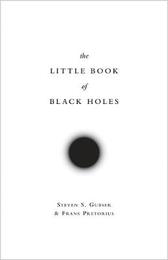
|
The Little Book of Black Holes
Hardback
Main Details
| Title |
The Little Book of Black Holes
|
| Authors and Contributors |
By (author) Steven S. Gubser
|
|
By (author) Frans Pretorius
|
| Series | Science Essentials |
|---|
| Physical Properties |
| Format:Hardback | | Pages:200 | | Dimensions(mm): Height 216,Width 140 |
|
| Category/Genre | Galaxies and stars |
|---|
| ISBN/Barcode |
9780691163727
|
| Classifications | Dewey:523.8875 |
|---|
| Audience | | Tertiary Education (US: College) | |
|---|
| Illustrations |
29 line illus.
|
|
Publishing Details |
| Publisher |
Princeton University Press
|
| Imprint |
Princeton University Press
|
| Publication Date |
10 October 2017 |
| Publication Country |
United States
|
Description
Dive into a mind-bending exploration of the physics of black holes Black holes, predicted by Albert Einstein's general theory of relativity more than a century ago, have long intrigued scientists and the public with their bizarre and fantastical properties. Although Einstein understood that black holes were mathematical solutions to his equations, he never accepted their physical reality - a viewpoint many shared. This all changed in the 1960s and 1970s, when a deeper conceptual understanding of black holes developed just as new observations revealed the existence of quasars and X-ray binary star systems, whose mysterious properties could be explained by the presence of black holes. Black holes have since been the subject of intense research - and the physics governing how they behave and affect their surroundings is stranger and more mind-bending than any fiction. After introducing the basics of the special and general theories of relativity, this book describes black holes both as astrophysical objects and theoretical 'laboratories' in which physicists can test their understanding of gravitational, quantum, and thermal physics. From Schwarzschild black holes to rotating and colliding black holes, and from gravitational radiation to Hawking radiation and information loss, Steven Gubser and Frans Pretorius use creative thought experiments and analogies to explain their subject accessibly. They also describe the decades-long quest to observe the universe in gravitational waves, which recently resulted in the LIGO observatories' detection of the distinctive gravitational wave 'chirp' of two colliding black holes - the first direct observation of black holes' existence. The Little Book of Black Holes takes readers deep into the mysterious heart of the subject, offering rare clarity of insight into the physics that makes black holes simple yet destructive manifestations of geometric destiny. 'A concise introduction to one of the Universe's strangest phenomena...It is probably just about right for a person who wants to acquire a rudimentary understanding of black holes, while also being a good introduction and stimulant for someone who might decide to explore further.' - Anthony Toole, Waterstones
Author Biography
Steven S. Gubser is professor of physics at Princeton University and the author of The Little Book of String Theory (Princeton). Frans Pretorius is professor of physics at Princeton. They both live in Princeton, New Jersey.
ReviewsPraise for The Little Book of String Theory: "Gubser ... does a masterly job of introducing string theory in simple terms and without using math."--Library Journal Praise for The Little Book of String Theory: "Steven Gubser provides a brief introduction to this complicated topic, and condenses an enormous amount of information into this 'little book.'"--ForeWord Praise for The Little Book of String Theory: "You will probably finish the book more confused than when you started, but in the best possible way: with profound questions and a desire to learn more."--New Scientist
|